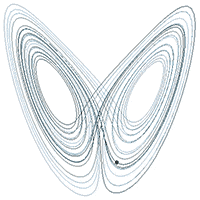Book Review - Chaos
September 08 2014I was looking for an interesting book on science when I came across a list of scientist biography recommendations on kottke. The list looks really promising and added to my queue of books (particularly the Isaacson biography of Einstein and Richard Holmes’ The Age of Wonder). However, the book that really caught my eye was Chaos: Making a New Science by James Gleick. The book is a good introduction (but also appropriately deep in science and theory) to the principles and history behind the study of Chaos theory. Gleick has been around, writing a bunch of interesting books on science (including three Pulitzer Prize finalists, including Chaos) and founding one of the first ISPs.

Chaos theory had its moment in the sun in the first Jurassic Park movie in the form of Dr. Ian Malcolm (played by Jeff Goldblum), a self-titled “chaotician”. Malcolm describes Chaos theory as “predictability in complex systems”, which does seem pretty close. He then talks about the butterfly effect, which is shorthand for the idea of high sensitivity to initial conditions in a system. Ultimately, the Jurassic Park conversation devolves into a riff on unpredictability, but I’m sure it was enough to pique the interest of many people, finally including me 21 years later.
Gleick starts with the butterfly effect and how Edward Lorenz discovered it during his meteorology simulations. Nate Silver actually devoted an entire chapter of this in his book, The Signal and the Noise. Lorenz was attempting to simulate the weather based on a few known equations that govern atmospheric pressure and related systems. One day, he attempted to restart his simulation given the intermediate results he had gotten. He found that the updated weather simulation produced widely divergent results compared to the first run, causing him to question how this could be given the equations were deterministic. It turns out the reason was he had manually put in the intermediate numbers by copying them off a printout and keying them in. The simulation itself was keeping a few more decimal places than what was on the printout. This was enough to completely change the course of the simulation. Lorenz found that certain systems are extremely sensitive to initial conditions. The butterfly effect refers to the possibility that a butterfly flapping its wings on one side of the world can cause a tornado or some such weather event in another part of the world. Lorenz came up with a set of equations that describe the Lorenz attractor, which shows that over time a system produces a familiar shape. However, the exact values are highly dependent on the initial conditions. The system also looks a little like a butterfly.

A more general way of describing Chaos is the study of dynamical systems. These are systems that aren’t completely deterministic, but over time (such as with the Lorenz attractor) appear to be stable. Eventually, Chaos helps study the human body. A really interesting observation here is that the human body is the ultimate chaotic system. Billions of moving parts are all happening and colliding at once, and those combine to keep the human heart beating. When the system (human body) finally becomes stable, that’s when death has occurred.
The book also dives deep on fractals, the concept of a self-repeating pattern that is repeated at different scales (computer scientists will immediately recall their first brush with recursion). My favorite example of this is when Mandelbrot asked the simple question of how long is the coast of Britain. The answer depends on how fine of a resolution (or how precise) is the measuring tool. There are so many twists and turns that if we measure finely enough, the length of the coast approaches infinity.
The book lost me a little bit in the second half as it doubles down on the breakthrough theories and concepts that moved Chaos theory forward. Concepts such as Universality (and Feigenbaum’s constants) and strange attractors are really interesting, but they are definitely harder to comprehend than the butterfly effect.
It’s striking to me how many of the discoveries made by these early scientists were made possible by computers. A lot of these discoveries needed computer programs to churn through thousands of calculations and, just as importantly, graph the results (particularly those that result in fractal patterns).
Finally, this book has reinforced for me how difficult it is to become an academic in math and physics. With physics, at least there’s usually some connection with the real world. The mathematicians are thinking at a much different level, a different plane from typical human comprehension. I very briefly considered an academic career in computer engineering (being this close to accepting admissions to UIUC to study fault tolerant computing). I’m so glad I didn’t. I think it takes a special mind and (especially) a special patience to do that life. Reading this book confirmed that for me.
comments powered by Disqus